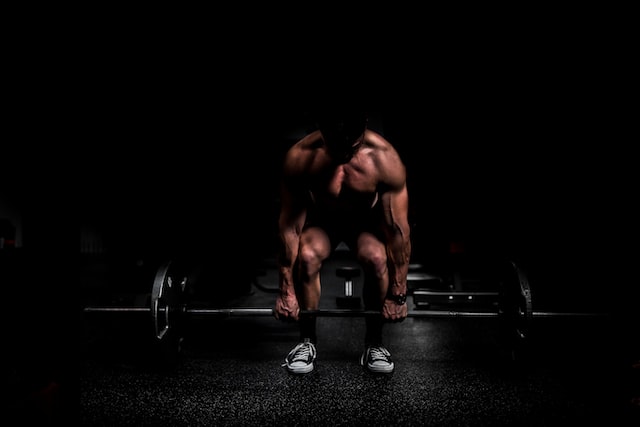Build bigger and stronger muscles with the trap bar
The trap bar is one of the most unusual types of weight training equipment in the gym. But it’s unique benefits means it needs to feature in your training programme if you want to maximise the size and strength of your muscles, says New Body Plan editorial director Joe Warner
The first time you step into a gym there’s one bit of weight-training equipment that requires a double take. While most of us know what a barbell is, or what dumbbells are, before we ever lift one, the same can’t be said of the trap bar.
If you saw it outside the weights room most people would guess it was a medieval torture device rather than one of the very best weight-lifting bars to develop bigger and stronger muscles. (Especially if you do the trap bar deadlift.) Here’s what you need to know about this clever bit of kit to get the results you want.
Find your perfect fat-loss plan!
Take the New Body quiz!
What is a trap bar?
A trap bar, also known as a hex bar, is a unique type of weight training equipment. In some ways it is a bit like a barbell, because the two bars share some similar traits. But it other ways it is very different. And it’s these differences that make this type of bar so good at building bigger and stronger muscles.
Why is it called a trap bar?
There a couple of theories about how the trap bar got its name. One is that the bar’s inventor, a competitive powerlifter called Al Gerard, named it because it worked the trapezius (or traps) muscles of the upper back when used to do shrugs. Another is that someone commented on how the bar looked like a bear trap and the name stuck. For those who call it a hex bar, read on to discover why.
The free arm workout for big and impressive biceps and triceps
How much does a trap bar weigh?
There is no agreed standard for the weight or indeed size of a trap bar. This is another major difference between trap bars and barbells. A standard Olympic barbell is 7ft (2.13m) long and weighs exactly 20kg (44lb). The weight of a trap bar can vary significantly between models. Some may weigh around the same as an Olympic barbell. Others can be up to 50% heavier (30kg) or more.
How is a trap bar similar to a barbell?
A trap bar is similar to a barbell in that it’s a long bar on to which you load weights plates to increase the total weight of the bar. You also can use it for similar moves, including deadlifts and shrugs.
How is a trap bar different to a barbell?
You only need to look at a trap bar to see the immediate differences. The most obvious is its shape. Most models have a large hexagonal shape as their middle section, with two different handle options that allow you to hold the bar with a neutral grip (more on this later). The hexagonal design means you to step in to the middle space of the bar. And it’s from this standing position you perform all trap bar exercises. Because you stand inside the frame of the bar, you can’t use it for any type of lunge exercise.
What makes a hex bar so good?
The main benefits of using a hex bar, especially for deadlifts, focus on the handles.
The big advantage is that the structure of the bar’s handles allows you to hold the bar with a neutral grip. A neutral grip means you hold a bar or weight with your palms facing one another. This grip position isn’t possible with Olympic barbells.
With Olympic bars you can only take an overhand grip (knuckles facing up), underhand grip (knuckles facing down) or alternate grip (one hand has knuckles up, the other hand has knuckles down). You’d only ever use an alternate grip for a barbell deadlift to gain a stronger grip than an overhand hand position.
And almost all hex bars offer two pairs of handles that provide two different grip heights. There’s a low handle and a high handle. You flip the bar over to access the the higher or lower handle position you want. Using a higher grip is a better option if you’ve got lower back or hamstring tightness or inflexibility, which prevents you getting low enough to deadlift with an Olympic barbell.
What lifts can I do with a trap bar?
The most popular lifts done with a trap bar are the trap bar deadlift, the trap bar Romanian deadlift (also known as the stiff-leg deadlift or straight-leg deadlift) and the trap bar shrug.
It can also be used for other moves, including high-intensity cardio training such as loaded jumps and loaded farmer’s walks. It can even be used for the overhead press, if you want to train your shoulders to move and manage a more unstable load. This will also work your abs harder than when using a barbell for the overhead barbell press.
What muscles does a trap bar work?
The main muscles worked with a trap bar depend on the exercise you’re doing.
The trap bar deadlift, just like a barbell deadlift, primarily works the glutes, hamstrings and lower back. But unlike when using a barbell, the trap bar places less strain on the lumber spine. So it’s a better option if you have had lower back problems or lack flexibility.
And because you stand inside the bar, instead of in front of it, executing a trap bar deadlift requires less technical proficiency that other deadlift variations. This makes it an excellent exercise for people new to deadlifting. And because these features mean you can likely lift heavier on a trap bar deadlift than conventional barbell deadlift, it’s a very useful tool for improving your barbell deadlift in a very safe way.
A trap bar shrug works your traps. And trap bar farmer’s walk works a huge variety of muscles. Whichever exercise you do, using this type of bar will always work your forearms, and so improve your grip strength.
Burn fat and lose your belly with the best cardio for weight loss
Are hex bar exercises better than barbell exercises?
It’s not as simple as saying any one move is better than another. Every single exercise should be thought of as a specific tool to do a specific job. Much like a toolbox has a hammer for hammering nails and a screwdriver for screwing screws, different exercises should be used for a specific purpose.
For example, hex bar deadlifts are a fantastic option if you have an injury history or movement issues that prevent you deadlifting with a barbell. But even if you can barbell deadlift with no problems, the hex bar variety should also feature in your training programme of the many advantages the move provides.
How can I find out how much a hex bar weighs?
If you always use the same hex bar it’s worth knowing how much it weights so you can track your lifts consistently. The easiest way is to ask a personal trainer, who should know the answer. If not, does your gym has moveable weight scales? If so, hop on and note your weight. Then hop on again holding the bar. Take the first number from the second number to work out the weight of the bar.
Do I include the weight of the hex bar in my total weight lifted?
If you know the exact weight of the bar, then yes. Add the weight of the bar to the weight of the plates to get the total weight, just as you would with an Olympic barbell.
If you don’t know the weight of the trap bar you have two options. Either always call it 25kg, and you’re never going to be too much further than 5kg out. Or simply record the total weight of the plates lifted. This is the same approach it’s wise to take when using a Smith machine and unsure of the weight of its barbell.
Find your perfect fat-loss plan!
Take the New Body quiz!

